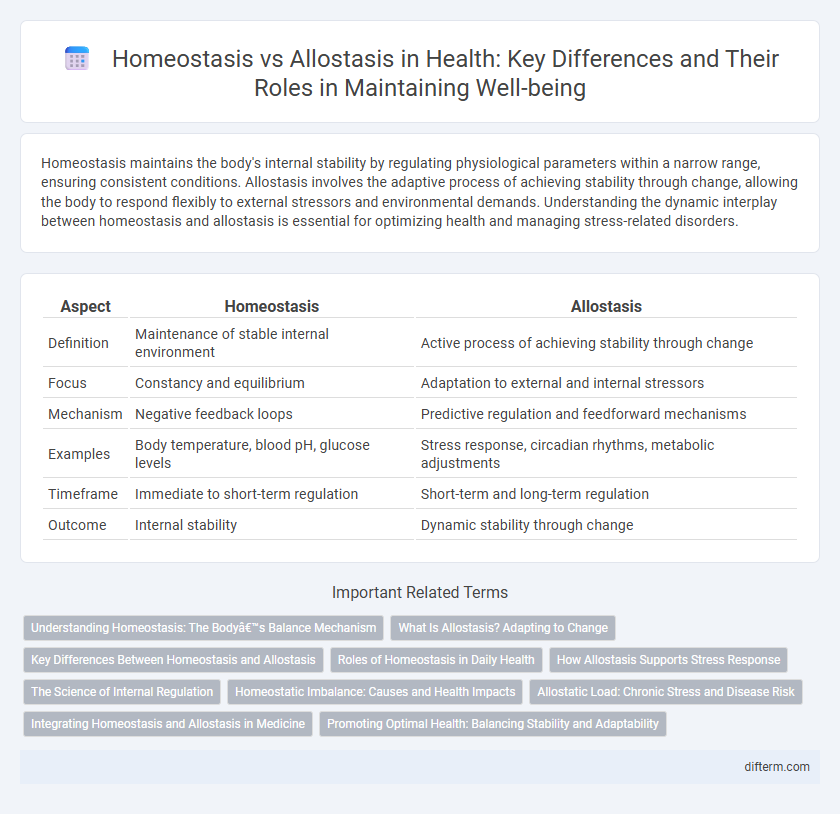Homeostasis maintains the body's internal stability by regulating physiological parameters within a narrow range, ensuring consistent conditions. Allostasis involves the adaptive process of achieving stability through change, allowing the body to respond flexibly to external stressors and environmental demands. Understanding the dynamic interplay between homeostasis and allostasis is essential for optimizing health and managing stress-related disorders.
Table of Comparison
| Aspect | Homeostasis | Allostasis |
|---|---|---|
| Definition | Maintenance of stable internal environment | Active process of achieving stability through change |
| Focus | Constancy and equilibrium | Adaptation to external and internal stressors |
| Mechanism | Negative feedback loops | Predictive regulation and feedforward mechanisms |
| Examples | Body temperature, blood pH, glucose levels | Stress response, circadian rhythms, metabolic adjustments |
| Timeframe | Immediate to short-term regulation | Short-term and long-term regulation |
| Outcome | Internal stability | Dynamic stability through change |
Understanding Homeostasis: The Body’s Balance Mechanism
Homeostasis maintains the body's internal environment by regulating temperature, pH, and glucose levels through negative feedback loops to achieve stability. Allostasis complements this process by anticipating stressors and initiating adaptive changes in physiological systems, ensuring the body can respond to dynamic challenges. Understanding homeostasis is crucial for recognizing how the body preserves equilibrium amid external and internal fluctuations.
What Is Allostasis? Adapting to Change
Allostasis is the body's dynamic process of achieving stability through physiological or behavioral change, allowing adaptation to stress and environmental challenges. Unlike homeostasis, which maintains internal balance by keeping variables constant, allostasis anticipates needs and adjusts parameters proactively to promote survival and resilience. This adaptive mechanism regulates hormones, immune responses, and cardiovascular functions to efficiently manage unpredictable stressors and maintain overall health.
Key Differences Between Homeostasis and Allostasis
Homeostasis maintains internal stability by regulating physiological variables within a narrow range, such as body temperature and blood glucose levels. Allostasis, in contrast, involves adaptive changes to achieve stability through dynamic adjustments in response to stressors or environmental challenges. Unlike homeostasis's fixed set points, allostasis employs predictive regulation to anticipate needs and allocate resources efficiently.
Roles of Homeostasis in Daily Health
Homeostasis maintains the body's internal environment by regulating temperature, pH, and glucose levels, ensuring optimal conditions for cellular functions. It supports daily health by balancing hydration, blood pressure, and electrolyte levels, essential for physical and cognitive performance. This steady-state regulation minimizes stress on organs and tissues, promoting overall well-being and resilience against illnesses.
How Allostasis Supports Stress Response
Allostasis supports the stress response by actively adjusting the body's physiological parameters to maintain stability under changing environmental demands, unlike homeostasis, which aims to keep internal conditions constant. It involves dynamic regulation of hormones, such as cortisol and adrenaline, to prepare the body for acute stress and promote adaptation. This process optimizes energy utilization and enhances survival by anticipating future needs and facilitating recovery after stress exposure.
The Science of Internal Regulation
Homeostasis maintains internal stability through fixed set points regulating body temperature, pH, and glucose levels, ensuring consistent physiological conditions. Allostasis anticipates and adapts to stressors by dynamically adjusting these parameters, enabling flexible responses to environmental changes. This distinction highlights the science of internal regulation as a balance between fixed equilibrium and predictive adaptation mechanisms.
Homeostatic Imbalance: Causes and Health Impacts
Homeostatic imbalance occurs when the body's regulatory systems fail to maintain internal stability, often due to factors such as chronic stress, infections, or nutritional deficiencies. This disruption can lead to diseases like diabetes, hypertension, and autoimmune disorders by impairing cellular functions and organ systems. Persistent imbalance undermines physiological equilibrium, increasing vulnerability to inflammatory responses and metabolic dysfunction.
Allostatic Load: Chronic Stress and Disease Risk
Chronic stress triggers allostatic load, a physiological burden resulting from prolonged activation of the body's stress response systems. This accumulation of wear and tear disrupts homeostasis, increasing the risk for diseases such as hypertension, cardiovascular disorders, and metabolic syndrome. Measuring allostatic load through biomarkers like cortisol levels and inflammatory markers helps predict long-term health outcomes linked to chronic stress exposure.
Integrating Homeostasis and Allostasis in Medicine
Integrating homeostasis and allostasis in medicine enhances understanding of the body's regulatory mechanisms by balancing stable internal conditions with adaptive responses to stress. Homeostasis maintains consistent physiological parameters, while allostasis enables dynamic adjustments to environmental challenges, promoting resilience and long-term health. This combined approach informs personalized treatment strategies, improving patient outcomes through predictive and adaptive care models.
Promoting Optimal Health: Balancing Stability and Adaptability
Homeostasis maintains internal stability by regulating physiological variables such as temperature, pH, and glucose levels to promote optimal health. Allostasis enhances adaptability through dynamic adjustments in response to environmental stressors, supporting long-term well-being and resilience. Balancing homeostasis and allostasis is crucial for sustaining health by integrating stability with flexible adaptation mechanisms.
homeostasis vs allostasis Infographic

 difterm.com
difterm.com